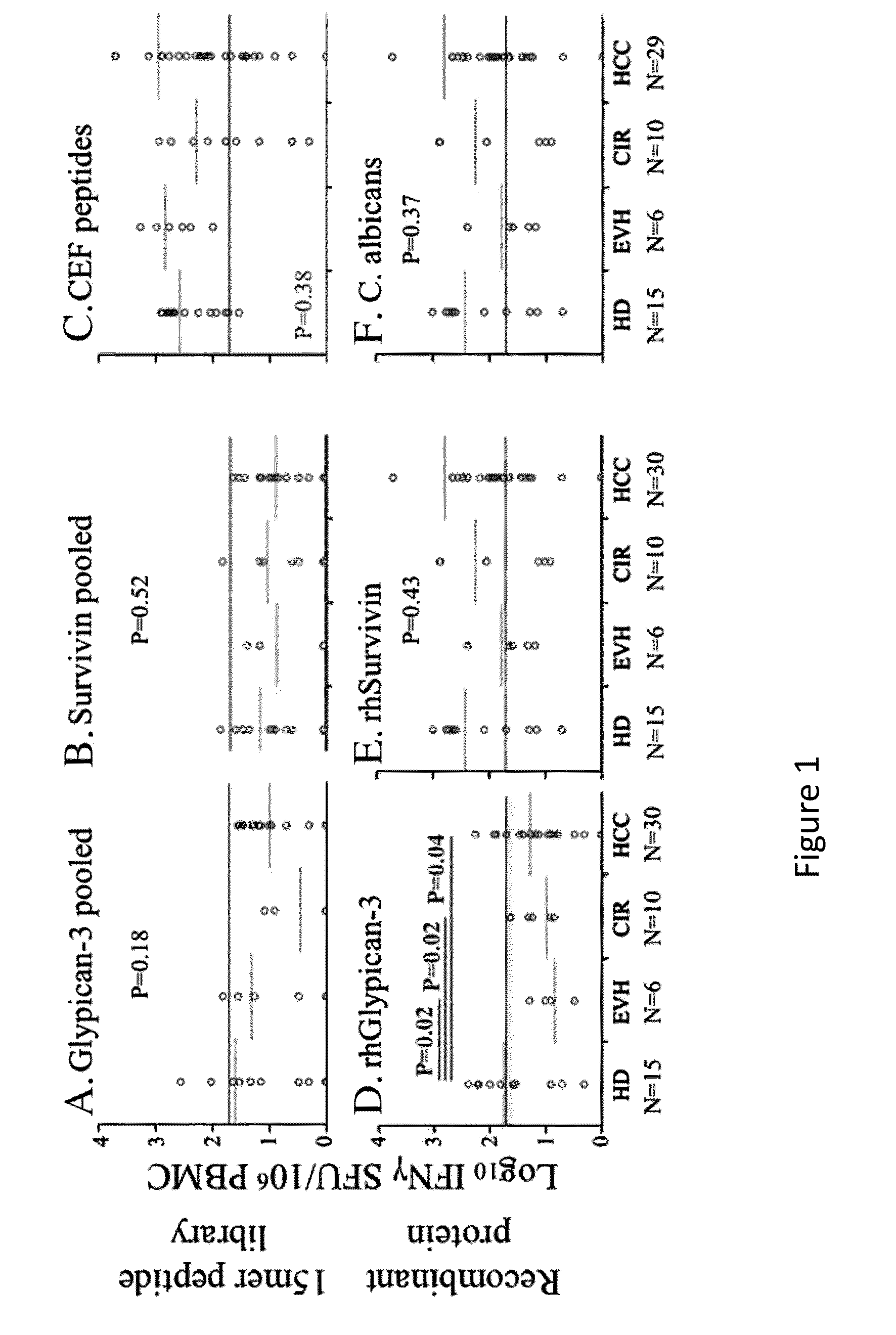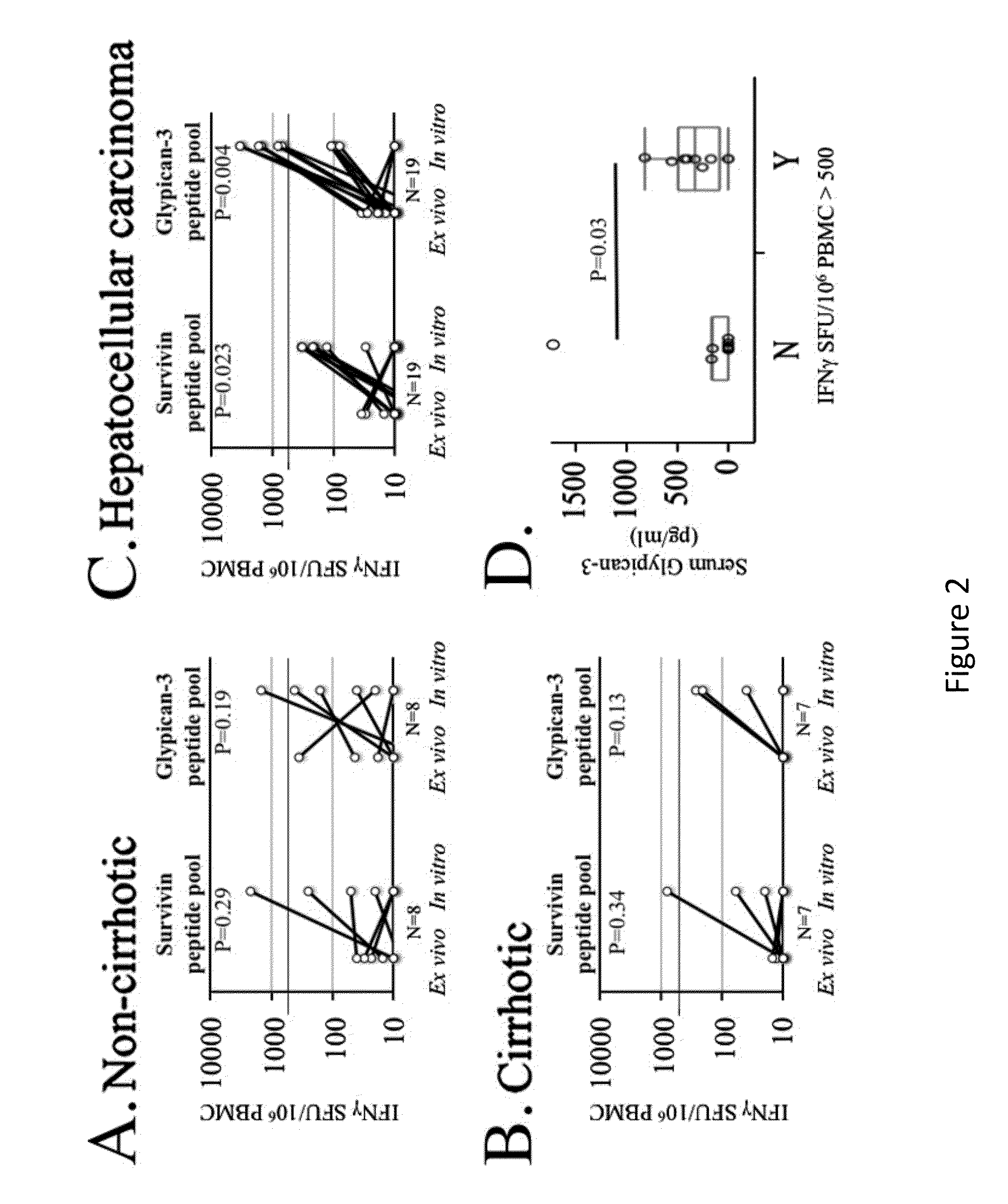Expansion of Interferon-Gamma-Producing T-Cells Using Glypican-3 Peptide Library
a technology of glypican-3 and t-cells, which is applied in the field of expansion of interferon-gamma-producing t-cells using glypican3 peptide library, can solve the problems of morbidity and mortality, hcc primarily, and precluded examination
- Summary
- Abstract
- Description
- Claims
- Application Information
AI Technical Summary
Benefits of technology
Problems solved by technology
Method used
Image
Examples
experimental examples
[0121]The invention is further described in detail by reference to the following experimental examples. These examples are provided for purposes of illustration only, and are not intended to be limiting unless otherwise specified. Thus, the invention should in no way be construed as being limited to the following examples, but rather, should be construed to encompass any and all variations which become evident as a result of the teaching provided herein.
[0122]Without further description, it is believed that one of ordinary skill in the art can, using the preceding description and the following illustrative examples, make and utilize the compounds of the present invention and practice the claimed methods. The following working examples therefore, specifically point out the preferred embodiments of the present invention, and are not to be construed as limiting in any way the remainder of the disclosure.
example 1
Expansion of Interferon-Gamma-Producing Multifunctional CD4+ T-Cells and Dysfunctional CD8+ T-Cells by Glypican-3 Peptide Library in Hepatocellular Carcinoma Patients
[0123]Glypican-3 is a promising target for immunotherapy for hepatocellular carcinoma, but limited data exist regarding its immunogenicity in patients with diverse HLA types, immunogenicity for CD4+ T-cells, and the impact of inhibitory co-stimulation on glypican-3-specific T-cells. Using a 15 mer overlapping peptide library for glypican-3, PBMC from patients with HCC were assessed ex vivo and after short-term in vitro expansion for tumor antigen-specific T-cell responses with and without blockade of PD-1 / PD-L1 and CTLA-4 signaling. It was observed that glypican-3-specific T-cells were undetectable ex vivo, but primarily IFNγ+TNFα+ CD4+ T-cells expanded with short-term in vitro stimulation in 10 / 19 (52%) patients. Glypican-3-specific CD8+ T-cells predominantly produced TNFα, but did not secrete IFNγ nor degranulate. CTL...
example 2
Expansion of CD8+ T-Cells Isolated from Normal Donors and Hepatocellular Carcinoma Patients Using Monocyte-Derived Dendritic Cells and Defined HLA-A2-Restricted Antigens
[0157]Experiments were designed to demonstrate that tumor antigen-specific CD8+ T-cells expanded from HLA-A2+ healthy donors using optimized antigen-presenting cells possess significantly greater affinity for their target antigen than similarly generated CD8+ T-cells from HLA-A2+ patients with hepatocellular carcinoma. In addition, experiments were designed to demonstrate that expression of cloned high-affinity HLA-A2-restricted tumor antigen-specific T-cell receptors (TCRs) derived from healthy donors in polyclonal T-cells from cirrhotic HCC patients confer potent tumor antigen-specific effector functions.
[0158]Briefly, CD8+ T-cells isolated from normal donors and hepatocellular carcinoma patients are expanded using monocyte-derived dendritic cells and defined HLA-A2-restricted antigens. The affinity and effector fu...
PUM
| Property | Measurement | Unit |
|---|---|---|
| Affinity | aaaaa | aaaaa |
| Antigenicity | aaaaa | aaaaa |
Abstract
Description
Claims
Application Information
 Login to View More
Login to View More - R&D
- Intellectual Property
- Life Sciences
- Materials
- Tech Scout
- Unparalleled Data Quality
- Higher Quality Content
- 60% Fewer Hallucinations
Browse by: Latest US Patents, China's latest patents, Technical Efficacy Thesaurus, Application Domain, Technology Topic, Popular Technical Reports.
© 2025 PatSnap. All rights reserved.Legal|Privacy policy|Modern Slavery Act Transparency Statement|Sitemap|About US| Contact US: help@patsnap.com



